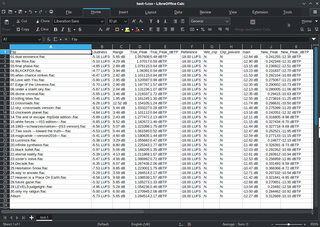Reception
This section may be too long and excessively detailed.(November 2023) |
After mentioning it in passing in their November 1986 edition, Macworld published an extensive review of the product in their May 1987 edition. It starts by noting that "If you didn't know there were any gaps left to fill in Excel, you will after you try Trapeze." They point out its ability to mix data, results, graphs and text as separate blocks in a single display, whereas at the time, Microsoft Excel required these to be on separate windows. They also note the program's inclusion of powerful formulas, like matrix manipulation, provided functionality that would require macros in Excel. Moreover, these elements were linked together and updated each other, meaning changes to the data would, for instance, immediately update a chart in the same window. They note that setting up a spreadsheet in Trapeze is more difficult because planning is needed to name the various sections, but once set up, "it is much easier to work with Trapeze than Excel, and it is useful to have all the information about a project in one file." They conclude "Although macros are needed to improve performance and the Undo feature has not been adequately implemented in version 1.0, we highly recommend Trapeze to anyone who needs to integrate text and graphics into spreadsheet output." [3]
Another major review appeared in the July 1987 edition of MacUser. The reviewer lauded the interface and the general concept of the system. He was especially impressed with the way formulas were constructed, by linking the names of blocks, and the way the results appeared in a new block that automatically sized itself to the result set, something he calls "magic". [7] He also notes that its ability to import graphics blocks means that, for example, one could create an invoice in MacPaint, import it as a background, and then lay out input and output (formula) blocks on top of the graphic to produce a graphical form. [8] But he also continually pointed out how different it was from other spreadsheet programs, noting "If you are a heavy spreadsheet users, Trapeze takes a lot of getting used to, and just plain doesn't do some things that other spreadsheets do." [7] Additionally, some of the functionality was either difficult to use or simply missing, notably the ability to import data from other spreadsheet programs which meant the only way to transport data was by copy and paste. The review concludes "Depending on what you need to accomplish, Trapeze could be exactly what you've been looking for, or it could be completely inappropriate." The capsule awards it 2.5 mice, of five, and calls it "An unwieldly spreadsheet that can produce beautiful output." [11]
InfoWorld published a two-page review of 2.0 in September 1987, which was extremely positive. Starting off by calling it "revolutionary", they laud the capability to combine calculations graphics and text, and that together they produce results that look like manually laid up desktop publishing output, but one that updates automatically as the numbers change. Having used an earlier version of the program and found the performance "reasonably fast", they note that the new version is much faster than Excel on machines using a FPU, and even on those lacking one, like the standard Mac SE, calculation times were the same as Excel but the load and save times were still much faster. They conclude that "Although it may be surpassed by Excel on some levels as a spreadsheet, or by Page Maker in page layout, Trapeze has some features that neither possesses. As a result, at $295 it represents a significant value for many Macintosh users" and award it a score of 8.3 out of 10. [4]
Macworld covered the program again in February 1988 as part of a spreadsheet roundup, which also included Excel, Lotus Jazz, MacCalc, and Microsoft Works. Trapeze easily beat all of the other programs in almost every feature, allowing much larger worksheets, no limit on the length of text strings (most others were limited to 256 characters or less) and generally more functions and features. [12] The review starts by saying Trapeze is "completely different" and so versatile it could be used as a page-layout program or for graphics editor without ever using the spreadsheet part. They say it is slightly confusing for new users as the document opens with nothing in it and it's up to the user to add items to get it going, but they feel power users will "revel" in its possibilities. Its support for the 68881 made it much faster than any of the other programs, and they suggest it is the best choice for complex sheets. Their only concern was the lack of import/export, limited only to WKS and even then only to the data itself, not the formulas. [2]








